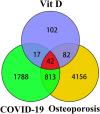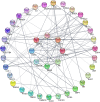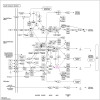Shared mechanisms and crosstalk of COVID-19 and osteoporosis via vitamin D
- PMID: 36307516
- PMCID: PMC9614744
- DOI: 10.1038/s41598-022-23143-7
Shared mechanisms and crosstalk of COVID-19 and osteoporosis via vitamin D
Abstract
Recently accumulated evidence implicates a close association of vitamin D (VitD) insufficiency to the incidence and clinical manifestations of the COVID-19 caused by severe acute respiratory syndrome coronavirus-2 (SARS-COV-2). Populations with insufficient VitD including patients with osteoporosis are more susceptible to SARS-COV-2 infection and patients with COVID-19 worsened or developed osteoporosis. It is currently unknown, however, whether osteoporosis and COVID-19 are linked by VitD insufficiency. In this study, 42 common targets for VitD on both COVID-19 and osteoporosis were identified among a total of 243 VitD targets. Further bioinformatic analysis revealed 8 core targets (EGFR, AR, ESR1, MAPK8, MDM2, EZH2, ERBB2 and MAPT) in the VitD-COVID-19-osteoporosis network. These targets are involved in the ErbB and MAPK signaling pathways critical for lung fibrosis, bone structural integrity, and cytokines through a crosstalk between COVID-19 and osteoporosis via the VitD-mediated conventional immune and osteoimmune mechanisms. Molecular docking confirmed that VitD binds tightly to the predicted targets. These findings support that VitD may target common signaling pathways in the integrated network of lung fibrosis and bone structural integrity as well as the immune systems. Therefore, VitD may serve as a preventive and therapeutic agent for both COVID-19 and osteoporosis.
© 2022. The Author(s).
Conflict of interest statement
The authors declare no competing interests.
Figures










Similar articles
-
Vitamin D in SARS-CoV-2 patients with non-invasive ventilation support.Panminerva Med. 2023 Mar;65(1):23-29. doi: 10.23736/S0031-0808.21.04277-4. Epub 2021 Jan 25. Panminerva Med. 2023. PMID: 33494567
-
No significant association between vitamin D and COVID-19: A retrospective study from a northern Italian hospital.Int J Vitam Nutr Res. 2021 Jun;91(3-4):200-203. doi: 10.1024/0300-9831/a000687. Epub 2020 Nov 2. Int J Vitam Nutr Res. 2021. PMID: 33135597
-
Vitamin D and COVID-19: It is time to act.Int J Clin Pract. 2021 Mar;75(3):e13748. doi: 10.1111/ijcp.13748. Epub 2020 Oct 27. Int J Clin Pract. 2021. PMID: 33012103 Free PMC article.
-
The interplay between hypovitaminosis D and the immune dysfunction in the arteriovenous thrombotic complications of the sever coronavirus disease 2019 (COVID-19) infection.Blood Coagul Fibrinolysis. 2023 Apr 1;34(3):129-137. doi: 10.1097/MBC.0000000000001212. Epub 2023 Mar 2. Blood Coagul Fibrinolysis. 2023. PMID: 36966750 Free PMC article. Review.
-
Vitamin D in the Covid-19 era: a review with recommendations from a G.I.O.S.E.G. expert panel.Endocrine. 2021 Jun;72(3):597-603. doi: 10.1007/s12020-021-02749-3. Epub 2021 May 17. Endocrine. 2021. PMID: 33999367 Free PMC article. Review.
Cited by
-
Disease progression associated cytokines in COVID-19 patients with deteriorating and recovering health conditions.Sci Rep. 2024 Oct 21;14(1):24712. doi: 10.1038/s41598-024-75924-x. Sci Rep. 2024. PMID: 39433797 Free PMC article.
References
Publication types
MeSH terms
Substances
Grants and funding
- 22ZDYF512/the development projects of Sichuan Science and Technology Department
- 2017LZXNYD-P01/the Science and Technology strategic cooperation Programs of Luzhou Municipal People's Government and Southwest Medical University
- 2019 LZXNYD-P01DUAN/the Science and Technology strategic cooperation Programs of Luzhou Municipal People's Government and Southwest Medical University
LinkOut - more resources
Full Text Sources
Medical
Research Materials
Miscellaneous

